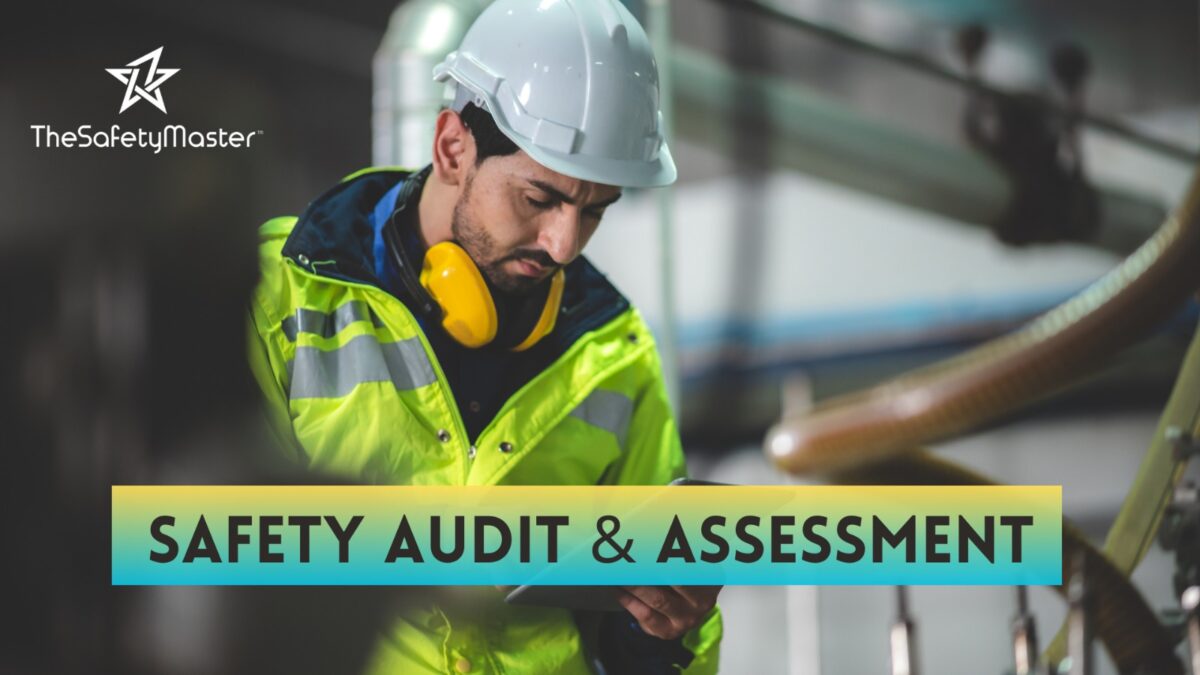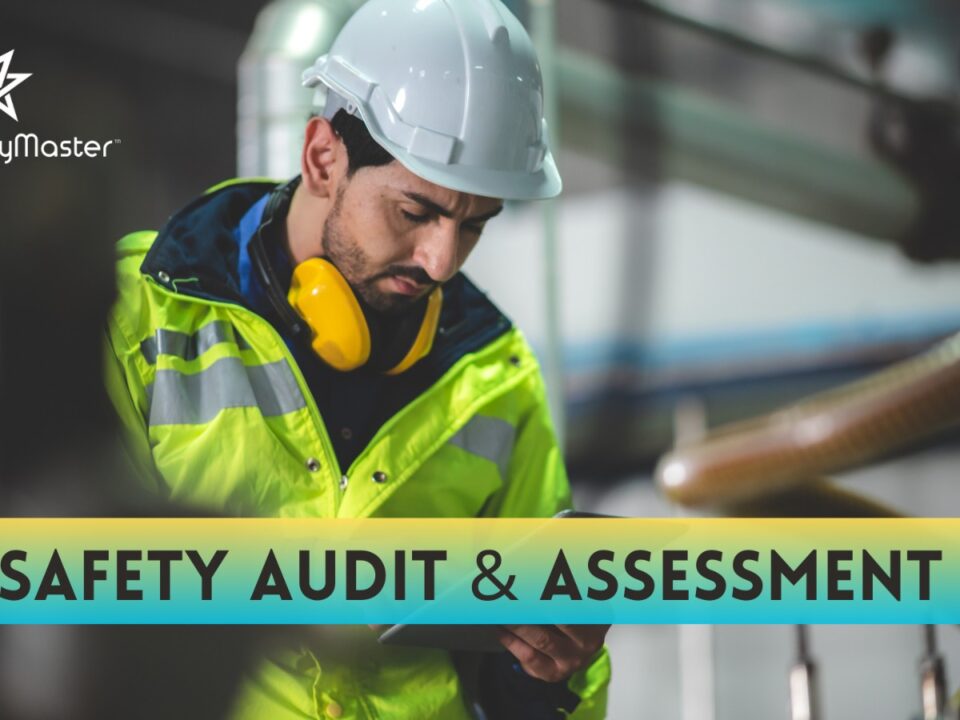Unlocking the Key to Occupational Safety: The Role of Comprehensive Safety Audits in Indian Industrial Landscape

Fire Safety Audit & Electrical Inspection Guide by The Safety Master
May 24, 2025
Fire Load Calculation: Key Factors to Consider for Optimal Safety in Indian Industrial Settings
May 27, 2025In this article, we delve into the paramount issue plaguing the Indian industrial landscape and shed light on an effective solution to ensure the key to occupational safety remains firmly in our grasp. Brace yourself as we explore the pivotal role of comprehensive safety audits in safeguarding the lives and well-being of workers. From uncovering potential hazards to implementing proactive measures, we unveil the powerful impact these audits can have on creating a secure work environment. Get ready to embark on a journey towards enhanced safety practices that promise a brighter and more secure future for all. Now, let’s embark on this insightful exploration together.
Introduction
Unlocking the Key to Occupational Safety: The Role of Comprehensive Safety Audits in Indian Industrial Landscape. Occupational safety is a paramount concern in any industrial setting, and India is no exception. As the country continues to experience rapid growth across various sectors, ensuring the well-being of workers becomes even more critical. However, with numerous hazards and risks associated with industrial operations, it becomes imperative to implement effective safety measures. This is where comprehensive safety audits play a pivotal role
Understanding the Importance of Occupational Safety in Indian Industries
In the vibrant tapestry of Indian industries, occupational safety emerges as a crucial thread that weaves together the fabric of productivity and well-being. Understanding the importance of occupational safety is paramount in ensuring a conducive work environment that preserves life, protects health, and upholds human dignity amidst industrial pursuits. Indian industries encompass a diverse range of sectors such as manufacturing, construction, and mining, where workers face various hazards and risks on a daily basis. Recognizing this reality, prioritizing occupational safety becomes not only an ethical imperative but also a strategic decision for organizations aiming to thrive in the long run. By safeguarding their workforce from harm, companies can foster loyalty, trust, and enhanced productivity.
Moreover, embracing robust safety measures contributes to social progress on a larger scale. As employees feel secure in their workplace environments and trust that their well-being is valued by their employers, job satisfaction and overall happiness flourish. This radiates beyond the walls of factories or offices into families, communities, and ultimately strengthens the foundation of society as a whole.
By delving into an understanding of occupational safety’s significance in Indian industries, we embark on a transformative journey towards nurturing resilient workplaces that empower individuals to flourish both personally and professionally. Through proactive measures aimed at mitigating risks and ensuring comprehensive safety audits are carried out effectively throughout various sectors, India can forge ahead on its path towards becoming an exemplar of occupational well-being in the global arena.
An Overview of Comprehensive Safety Audits
An Overview of Comprehensive Safety Audits: Safety audits serve as a critical tool in the pursuit of occupational safety excellence within the Indian industrial landscape. A comprehensive safety audit involves a systematic examination and evaluation of an organization’s safety practices, procedures, and compliance with regulatory requirements. It delves deep into various aspects of workplace safety, including physical hazards, standard operating procedures, employee training programs, emergency preparedness measures, and the overall safety culture prevailing within the organization.
By conducting comprehensive safety audits, organizations gain valuable insights into their existing occupational safety systems and identify areas for improvement. These audits assess the effectiveness of risk management strategies in place and provide an opportunity to proactively address potential hazards and risks before they escalate into accidents or injuries. Through a holistic approach to auditing that encompasses both proactive measures and reactive responses to incidents or near misses, organizations can create a safe working environment that protects employees from harm.
Comprehensive safety audits not only focus on compliance with regulatory requirements but also prioritize the development of a robust safety culture. By emphasizing employee engagement and participation in identifying hazards and suggesting improvements, these audits foster a sense of ownership among workers towards their own well-being. This inclusivity promotes trust between management and employees while reinforcing the belief that occupational safety is a shared responsibility. As organizations strive to achieve higher levels of safety performance through comprehensive audits, they pave the way for sustainable growth while safeguarding their most valuable asset—their workforce.
The Legal Framework for Safety Audits in Indian Industries
The Legal Framework for Safety Audits in Indian Industries: Within the Indian industrial landscape, the implementation of comprehensive safety audits is not a mere choice but a legal obligation. The legal framework governing safety audits is primarily established by the Factories Act, 1948, which sets out regulations to ensure occupational safety and health in factories across the country. In addition to this act, various other legislation and guidelines complement the legal framework for safety audits.
These laws encompass provisions related to workplace safety standards, risk assessment protocols, emergency response planning, welfare facilities for workers, and employee training requirements. Compliance with these regulations ensures that industries prioritize the well-being of their workforce while mitigating potential occupational hazards and dangers on-site.
With a robust legal system in place mandating safety audits, Indian industries are compelled to proactively assess their operational environments. This legal framework not only promotes accountability but also instils a sense of responsibility among employers to continuously monitor and improve workplace conditions. By adhering to these regulations through thorough safety audits, companies can create safer work environments that prioritize employee well-being above all else – ensuring that workers return home unharmed at the end of each day.
Key Objectives of Safety Audits in Indian Industry
Key Objectives of Safety Audits in Indian Industry: Safety audits play a pivotal role in ensuring the well-being of workers and maintaining a secure working environment in Indian industries. These audits aim to achieve several essential objectives, each contributing to an enhanced culture of safety. Firstly, safety audits help identify potential hazards and risks through meticulous examination of workplace conditions, processes, and equipment. By conducting comprehensive inspections, organizations can proactively recognize any dangers that may jeopardize worker safety.
Secondly, safety audits evaluate the level of compliance with regulatory requirements and standards set by relevant authorities. This helps organizations ensure that they are meeting legal obligations and following industry best practices. Moreover, these audits provide an opportunity for companies to assess their adherence to specific safety protocols prescribed for different sectors, fostering a culture where safety is prioritized above all else.
Thirdly, safety audits encourage employee engagement and participation in creating safer workplaces. By involving workers in the audit process through interviews or surveys, companies demonstrate their commitment to valuing employee input on matters concerning health and safety. This inclusive approach not only empowers employees but also strengthens their sense of ownership over their own well-being.
In essence, the key objectives of safety audits in Indian industry encompass hazard identification, compliance evaluation, and employee involvement—all aimed at cultivating a proactive approach towards occupational safety with the ultimate goal of preventing accidents or injuries within the workplace.
The Role of Safety Audits in Identifying Hazards and Risks
In the quest for occupational safety in the Indian industrial landscape, comprehensive safety audits play a pivotal role in identifying hazards and risks that may endanger workers’ well-being. These audits involve a meticulous examination of work processes, equipment, and environmental factors to pinpoint potential threats. By scrutinizing various aspects of operations, including machinery maintenance practices, chemical handling procedures, and ergonomic considerations, safety audits serve as an indispensable tool in understanding the risk landscape. Not only do safety audits shed light on existing hazards but they also have the power to uncover hidden risks that may have gone unnoticed. This holistic approach allows organizations to proactively address potential dangers before they escalate into accidents or injuries. By thoroughly examining workspaces, materials used, and employee behaviours, safety auditors can bring attention to seemingly insignificant factors that could have significant consequences if left unattended.
Furthermore, safety audits enable organizations to adopt risk mitigation strategies that foster a culture of prevention rather than reaction. Identifying hazards empowers organizations to take proactive measures such as implementing engineering controls or modifying work processes to eliminate or minimize risks altogether. By taking pre-emptive actions guided by thorough audit findings, companies create safer working environments where employees can confidently perform their tasks without fear for their well-being.
The potency of safety audits extends beyond mere compliance with regulatory requirements; it instils a sense of ownership among employees regarding their own safety and the overall well-being of their colleagues. When workers witness management’s commitment towards ensuring safe working conditions through regular audits and subsequent corrective actions taken based on audit findings they are more likely to proactively participate in maintaining high standards of occupational safety on a day-to-day basis
Assessing Safety Compliance and Regulatory Requirements through Audits
Assessing Safety Compliance and Regulatory Requirements through Audits: Safety compliance and adherence to regulatory requirements are paramount in ensuring a secure working environment. Comprehensive safety audits play a pivotal role in evaluating the extent to which businesses adhere to these crucial guidelines. By conducting thorough inspections, audits provide an opportunity to identify areas where companies may be falling short, allowing for corrective measures to be taken promptly.
During safety audits, meticulous attention is paid to various parameters, including the implementation of safety policies, availability and functionality of safety equipment, proper handling of hazardous materials, and compliance with prescribed safety protocols. Auditors meticulously review documentation, inspect work areas, interview employees at all levels, and analyse incident records to assess if organizations are meeting the established legal requirements.
Through these audits, potential gaps in compliance are identified and addressed proactively. This not only ensures that organizations avoid penalties or legal repercussions but also fosters a culture of safety consciousness among employees. Moreover, it instils confidence among stakeholders that companies prioritize the well-being of their workforce and value their responsibilities as corporate citizens. Ultimately, such an approach promotes productivity by reducing accidents and creating an optimistic work environment where employees feel safe and valued.
Enhancing Safety Culture and Employee Engagement through Audits
Enhancing Safety Culture and Employee Engagement through Audits: The cultivation of a robust safety culture within an industrial setting is pivotal to ensuring occupational safety. Comprehensive safety audits play a pivotal role in fostering this culture, serving as catalysts for employee engagement and empowerment. By involving workers at every level of the organization in the audit process, companies can create a sense of ownership and responsibility for safety practices.
Through safety audits, employees are given the opportunity to actively participate in identifying hazards, assessing risks, and proposing mitigation strategies. This involvement not only increases their awareness but also instils a sense of pride in contributing to the overall well-being of their colleagues. The knowledge gained from audits empowers employees to become proactive advocates for safe practices, promoting a positive safety culture throughout the organization.
Furthermore, safety audits provide an avenue for open communication between management and workers. Employees are encouraged to voice their concerns and suggestions during audit discussions, which fosters trust and transparency. By acknowledging the importance of worker input, companies can create an inclusive environment where everyone feels valued and supported. This collaborative approach not only improves employee morale but also strengthens their commitment towards maintaining a safe work environment.
By prioritizing employee engagement through comprehensive safety audits, Indian industries have the potential to transform their workplaces into thriving hubs of productivity and well-being. Embracing this holistic approach ensures that no stone is left unturned when it comes to occupational safety, creating an atmosphere where employees feel empowered to prioritize their own well-being as well as that of their co-workers
Mitigation Strategies and Corrective Actions Derived from Safety Audits
Mitigation Strategies and Corrective Actions Derived from Safety Audits: Once safety audits have been conducted in Indian industries, the next crucial step is to implement appropriate mitigation strategies and corrective actions. These measures are essential for addressing the identified hazards and risks, ensuring a safer working environment for all employees.
One effective mitigation strategy derived from safety audits is the implementation of comprehensive training programs. By providing employees with the necessary knowledge and skills to identify potential hazards and follow safety protocols, companies can greatly reduce workplace accidents. This proactive approach not only enhances employee safety but also fosters a culture of awareness and accountability.
Another corrective action that arises from safety audits is the regular maintenance and inspection of equipment. Identifying any faulty machinery or outdated systems through audits allows companies to promptly replace or repair them, mitigating potential risks. By investing in reliable equipment, organizations can promote a safe working environment while increasing productivity.
Additionally, safety audits often reveal areas where improvements can be made in terms of workplace layout and design. Companies can leverage these findings to redesign workspaces, create clear pathways, install proper signage, or implement ergonomic measures that prioritize employee well-being.
By implementing these mitigation strategies derived from safety audits, Indian industries can significantly reduce workplace accidents, injuries, and fatalities. Ultimately, this will foster a safer working environment where employees feel valued and protected—a positive outcome for both individuals and organizations alike.
Implementing Safety Audits in Indian Industrial Landscape: Challenges and Solutions
Implementing Safety Audits in Indian Industrial Landscape: Challenges and Solutions Indian industries face unique challenges when it comes to implementing comprehensive safety audits. One of the primary challenges is the diverse nature of industries, ranging from manufacturing to construction, each with its own set of risks and hazards. This necessitates tailoring safety audit processes to suit specific industry requirements while maintaining a cohesive framework.
Another major challenge is ensuring buy-in from top management and creating a culture of safety within organizations. Many companies may view safety audits as a mere compliance exercise rather than an opportunity to foster a safe work environment. To overcome this, it is crucial to educate leaders on the long-term benefits of audits in terms of reducing accidents, improving productivity, and enhancing employee morale.
Additionally, resource constraints can pose challenges during implementation. Conducting thorough audits requires trained personnel, time allocation, and financial investment. However, innovative solutions such as leveraging technology for remote auditing or sharing resources among organizations in the same industry can help overcome these barriers.
By addressing these challenges head-on and adopting creative solutions, Indian industries can successfully implement comprehensive safety audits that enhance workplace safety standards across various sectors. Such proactive efforts will not only protect workers’ well-being but also contribute to sustainable growth and development in the Indian industrial landscape as a whole.
Aligning Safety Audits with International Standards and Best Practices
Aligning Safety Audits with International Standards and Best Practices: In order to establish a robust safety culture, it is imperative for Indian industries to align their safety audits with international standards and best practices. By doing so, they can ensure that the safety audit process reflects globally accepted benchmarks, leading to enhanced occupational safety outcomes.
Internationally recognized standards such as the ISO 45001 provide a comprehensive framework for managing occupational health and safety risks. Incorporating elements of these standards into safety audits can help Indian industries assess their compliance with global best practices. This alignment not only strengthens organizational safety systems but also fosters a sense of confidence among stakeholders.
Furthermore, embracing international best practices enables Indian industries to learn from successful strategies adopted by other nations. By benchmarking against established global leaders in terms of occupational safety, organizations can identify areas for improvement and implement effective corrective actions. This continuous improvement approach not only enhances workplace safety but also contributes to increased productivity and employee satisfaction.
Overall, aligning safety audits with international standards and best practices elevates the level of occupational safety in Indian industries. It demonstrates a commitment towards excellence in ensuring the well-being of employees and contributes to India’s journey towards becoming a global leader in workplace health and safety standards.
Evaluating the Effectiveness and Impact of Safety Audits in Indian Industries
Evaluating the Effectiveness and Impact of Safety Audits in Indian Industries: With safety being a paramount concern in Indian industries, evaluating the effectiveness and impact of safety audits becomes crucial. By systematically analysing the data derived from audits, organizations gain valuable insights into their safety performance. These evaluations help measure the extent to which safety goals have been achieved and identify areas for improvement.
One key aspect of evaluating safety audits is assessing the reduction in incidents and accidents within workplaces. By comparing pre-audit and post-audit data, companies can determine whether their safety measures have resulted in a decline in incidents, thereby protecting employees from harm. Additionally, they can gauge how well their corrective actions have been implemented and whether they are effective in preventing future mishaps.
Another significant factor to evaluate is the impact of safety audits on improving overall safety culture within organizations. Safety audits not only identify hazards but also prompt active engagement among employees towards ensuring workplace safety. This heightened awareness fosters a culture where all individuals take responsibility for maintaining a safe working environment, ultimately benefiting both employees and employers alike.
Furthermore, assessing the cost-effectiveness of safety audits is essential for organizations to justify their investment in such initiatives. Evaluating factors such as reduced medical expenses, decreased insurance premiums due to improved risk management practices, and increased productivity resulting from enhanced employee morale provides tangible evidence of the positive impact that comprehensive safety audits bring to Indian industries.
In conclusion, evaluating the effectiveness and impact of safety audits in Indian industries offers valuable insights into reducing incidents, enhancing safety culture, and achieving cost-effectiveness. By continually analysing audit outcomes and implementing corrective actions accordingly, companies contribute towards creating safer workplaces for their employees while simultaneously experiencing increased productivity and business success.
Conclusion
With an unwavering commitment to occupational safety, Indian industries have embraced comprehensive safety audits as a crucial tool in mitigating workplace hazards and promoting a culture of safety. By identifying risks, ensuring regulatory compliance, and implementing corrective actions, these audits contribute significantly to the well-being of employees and the sustainability of businesses. As industries align their safety audits with international standards and best practices, there is an optimistic outlook for the future. Through continued dedication to safety, Indian industrial landscape will continue to flourish harmoniously with human welfare at its core. The key is unlocking a safer tomorrow through the power of comprehensive safety audits.




